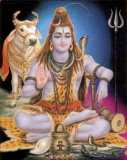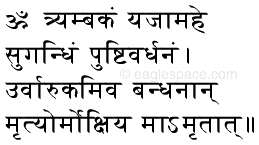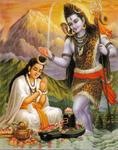Aum Trayambakam Yajamahe,
Sugandhim Pushtivardhanam;
Urva Rukamiva Bandhanaan,
Mrityor Mokshiye Maamritat.
Sugandhim Pushtivardhanam;
Urva Rukamiva Bandhanaan,
Mrityor Mokshiye Maamritat.
ॐ त्रियम्बकं यजामहे, सुगन्धिं पुष्टिवर्धनं
उर्वारुकमिव बन्धनान् मृत्योर्मोक्षिय मामृतात्
उर्वारुकमिव बन्धनान् मृत्योर्मोक्षिय मामृतात्
OM triyambakam yajāmahe sugandhim pushTivardhanam,
urvārukamiva bandhanān mrrityormokshiya māmrritāt.
urvārukamiva bandhanān mrrityormokshiya māmrritāt.
Summary of the Maha Mrityunjaya Mantra
We worship Shiva - The Three-Eyed (tryambakam) Lord (yajamahe);
Who is fragrant (sugandhim) and nourishes (pushti) and grows (vardhanam) all beings.
As the ripened cucumber (urvarukamiva) isautomatically liberated (bandhanaan) (by the intervention of the "farmer") from its bondage to the creeper when it fully ripens;
May He liberate us (mokshiya) from death (mrityor), for the sake of immortality (maamritaat).
Who is fragrant (sugandhim) and nourishes (pushti) and grows (vardhanam) all beings.
As the ripened cucumber (urvarukamiva) is
May He liberate us (mokshiya) from death (mrityor), for the sake of immortality (maamritaat).
We pray to Lord Shiva whose eyes are the Sun, Moon and Fire
May He protect us from all disease, poverty and fear
And bless us with prosperity, longevity and good health.
May He protect us from all disease, poverty and fear
And bless us with prosperity, longevity and good health.
The Maha Mrityunjaya Mantra is a prayer to Lord Shiva (part of the hindu trinity, the lord of destruction, penance and meditation) for help in overcoming "death". The seeker is more concerned with avoiding spiritual "death" rather than physical "death". The mantra is a request to Lord Shiva to lead us to the mountain of meditation, which is indeed Lord Shiva's abode.
Legend has it that Lord Shiva appeared before his devotee Markandeya (who was destined to die at the age of sixteen) and stopped his aging process a few days before he was supposed to turn sixteen. Thus, death would never be able to claim him! Hence, this mantra is also referred to as the Markandeya mantra in classical hindu studies. The mantra should ideally be repeated 108 times, twice daily, at dawn and at dusk. It is particularly useful for meditation and yoga practice.
Legend has it that Lord Shiva appeared before his devotee Markandeya (who was destined to die at the age of sixteen) and stopped his aging process a few days before he was supposed to turn sixteen. Thus, death would never be able to claim him! Hence, this mantra is also referred to as the Markandeya mantra in classical hindu studies. The mantra should ideally be repeated 108 times, twice daily, at dawn and at dusk. It is particularly useful for meditation and yoga practice.
Spiritual Significance of the Shiva Mahamantra
Lord Shiva is referred to as tryambakam, the three-eyed one, because his third-eye has been "opened" by the powers of penance and meditation. The third eye is said to be located in the space between the eyebrows, and is "opened" when one experiences spiritual awakening. So, when we pray to Lord Shiva, we are in essence asking for his blessings and assistance in opening our third eye of spiritual knowledge.The natural consequence of this awakening is that we will be led towards spiritual liberation or moksha, and attain freedom from the cycles of death and rebirth. The goal of chanting this mantra is to spiritually "ripen" so that
Lord Shiva Mrityunjay Mahamantra Audio mp3 download
- Listen to or Download the Mrityunjaya Mantra (mp3 260K) for yoga and meditation
- This rendition of the Mrityunjaya Mantra is from the "Chants of India" CD by Ravi Shankar. This CD is a must for anyone interested in exploring other mantras. All the tracks are excellent, including the Gayatri Mantra.Chants of India by Ravi Shankar
- Listen to or Download the Mrityunjay Mahamantra (mp3 204K) for yoga and meditation
- This rendition of the Mrityunjaya Mantra is a short extract of a 5:21min rendition from the "Mahamantras" CD by Pandit Jasraj. This CD contains several other mahamantras dedicated to Ganesha, Lakshmi and many more!
- Listen to or Download the Tryambkam Mrityunjay Mahamantra (mp3 165K) for yoga and meditation
- This rendition of the Mrityunjaya Mantra is a short extract from the "Garland of Moksha Mantras" CD by Yogi Hari. US visitors can purchase the full song (track 18) or the full Garland of Moksha Mantras album
Paarvati Devi Mantra
Sarva-mangal-maangalye, Shive Sarvaarth-saadhike
Sharanye-triyambake Gauri, Naaraayani Namo-stute
सर्वमङ्गलमाङ्गल्ये शिवे सर्वार्थसाधिके | Sharanye-triyambake Gauri, Naaraayani Namo-stute
शरण्येत्र्यम्बके गौरि नारायणी नमोsस्तुते || The Goddess Paarvati (or Gauri), the consort of Lord Shiva, is praised through this mantra. Paarvati is the one who brings good fortune and prosperity (-mangal-maangalye) to all (-sarva) her devotees. She is the one who is always and forever (-sarvaarth) accompanying Lord Shiva in all his meditations (-saadhike). O beautiful and fair-colored one (-gauri), please give us refuge (-sharanye) in the protection of the three-eyed one (-triyambake). We bow to you repeatedly as we sing the praises (namo-stute) of our protector, Goddess Paarvati (-naarayani), the consort of Lord Shiva.
- New! Listen to the Paarvati Devi Mantra (mp3 224K)
- This rendition of the Paarvati devi Mantra is a short extract from the "Mahamantras" CD by Pandit Jasraj.




No comments:
Post a Comment